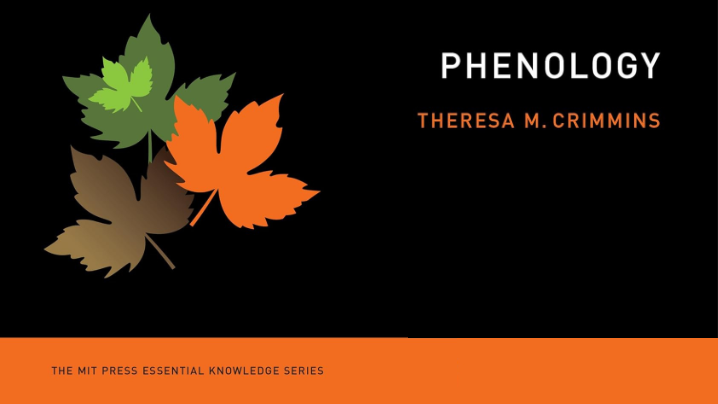
USA-NPN Director Theresa Crimmins' first book, Phenology, is available now on Amazon, Barnes and Noble, Books a Million, and more. Use code READMIT20 for 20% off orders through Penguin Random House with a US mailing address.
Theresa is very excited to share this book with you. This basic primer on the topic of phenology provides a thorough summary of what phenology is, how it is changing, why we should care. Her hope is that it will be a helpful resource for Local Phenology Programs, students and educators, and anyone interested in gaining a deeper understanding of the topic.
Theresa presented a webinar during Phenology Week sharing anecdotes and stories from the book! It was a great time celebrating the signs of the seasons!
Read an excerpt on the MIT Press Reader »
Below, an excerpt from Phenology -
"We are living in a period where “not normal” is normal. As I write this, in the summer of 2023, record-setting wildfires are burning out of control in nearly every Canadian province, and the smoke is choking much of Canada and large swaths of the eastern U.S. Just three years ago, wildfires burned for weeks in the mountains just north of Tucson, where I live. At night, we watched the flames engulf individual ponderosa pine trees from our backyard. At times, it’s hard to not feel immobilized by despair.
Also happening as I write this: a mother broad-billed hummingbird is incubating two mini jellybean-sized eggs in a nest made of fluff and grass a mere five feet from my desk. As I work, Mama Hummer whizzes from the nest down to the yellow bells blooms for a sip of nectar and then back to the nest, then over to the desert honeysuckle for another snack, and then back to the nest. This is the third year in a row that this creature has nested on our back porch, building her nest precariously on a string of twinkle lights just feet from the screen door that slams shut with a loud BANG. I cannot fathom her choice of nest location, though I am forever grateful, because watching baby hummingbirds fledge is nothing short of magical. At times, it’s hard not to feel bowled over by wonder.
Over the last 150 years, the world’s climate has changed noticeably. A century and a half ago, 110⁰F days were rare, occurring only once or twice a season here in Tucson, Arizona. This summer, we are setting records for daily high temperatures and sustained extremely hot conditions, with 17 days overtopping 110⁰F. The news is full of reports of our iconic saguaro cacti dropping arms and of beehives melting in Phoenix, where it has been exceptionally hot. And this record hot year follows on the heels of many other record hot years: eight of the past 20 years have been the warmest on record in Arizona. The impacts to hummingbirds, as well as to other plants and animals and humans are becoming more apparent each year.
In particular, our mental health is taking a hit. Anxiety and depression related to climate change and its consequences are increasingly common maladies. Google searches for “climate anxiety” increased five-fold in 2021 and mental health experts are fielding a rapidly growing number of requests for help dealing with eco-anxiety, eco-grief, and climate doom. It is far too big of a problem for any of us to address alone. Timothy Morton, an environmental philosopher, has labeled climate change a “hyperobject” – something too big to comprehend or assimilate into our individual, day-to-day existences. Evidence of rapid and unprecedented change surrounds us, and the news is persistently and painfully gloomy and doomy. The impacts of changes we can make on a personal level feel like a raindrop in an ocean-sized problem. I often find myself either frustrated and disappointed that I’m not doing more or disheartened and drained by the constant drumbeat of bad news followed by more bad news.
However, watching Mama Hummingbird tend to her babies has taught me that focusing on the small wonders unfolding in my midst calms and refocuses my scattered and anxious thoughts. My routine of circling the yard to collect phenology observations, originally established to generate records of seasonal phenomena, brings me so much more. Pausing to witness leaves unfurling and insects’ dogged activity serves to reframe the world for me. This shift in perspective, offering relief from climate anxiety, is accessible to everyone. Just about everyone understands “blooming” and “mating”, and anyone can document these phenomena – no formal training or specialized equipment necessary."